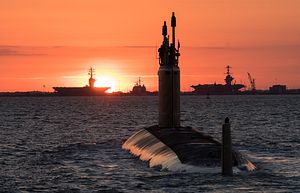A Chinese research expedition claims to have made major breakthroughs operating Unmanned Underwater Vehicles (UUV) collecting hydrographic information with potentially significant military application for submarine operations. While the original Chinese report hints at some possible advances in underwater data transmission, most subsequent reporting exaggerates the UUVs’ potential tactical utility as tools against foreign submarines.
Xinhua reported that scientists aboard the research vessel Kexue are operating 12 UUVs simultaneously for the next month collecting hydrographic data like salinity, temperature, turbidity, and current information that is being transmitted back in real-time. While details are sparse, two advances are implied, in operating multiple UUVs in coordination, and in underwater data transmission relaying the information they collect to data centers in real-time.
The South China Morning Post provided some amplifying details on the Kexue’s work. The UUVs, called Haiyis, are a type of buoyancy glider. Buoyancy gliders have been in use for years to collect hydrographic data for both civil and military uses. Unlike most UUVs that operate like small submarines, they do not rely on powered propulsion. Instead, buoyancy controls cause the glider to cyclically rise and sink, and as it does, the flow of water over the glider’s “wings” propel it forward.
Being freed of consuming power for propulsion gives glider UUVs great endurance, months in some cases, and the ability to survey large swaths of the ocean. Because of the difficulty transmitting data through water as opposed to through the air, gliders generally keep the data they collect stored to be downloaded when the UUV itself is retrieved, or is transmitted when the gliders come shallow and their antennae is near the surface of the water.
The U.S. Navy has operated glider UUVs for years. Called Littoral Battlespace Sensing-Gliders (LBS-G), they are used by the Navy’s oceanographers to collect hydrographic data such as temperature and salinity. In a major incident last December, the Chinese Navy seized an LBS-G in the South China Sea while it was being retrieved by a U.S. Navy research vessel. China returned the UUV to the U.S. Navy after five days.
Following last December’s incident, the U.S. Navy’s chief oceanographer, Rear Admiral Tim Gallaudet, explained that the hydrographic information UUVs collected was used to build models of the ocean environment for military applications. When the contracts for the LBS-G were finalized, defense industry press noted the importance that the hydrographic data they collect has on submarine operations by improving understanding of sound propagation through the water, affecting sonar performance.
But speculation on the Haiyi’s military potential goes far beyond normal hydrographic data gathering. An earlier report from the South China Morning Post on the Haiyi glider reported it being able to switch from its data-gathering role “into action against a designated target, such as submarine” or operating in large groups “like a pack of wolves” in search of prey.
Despite this reporting, it is doubtful that buoyancy gliders could usefully fill those sub-hunting roles. Both would require the real-time underwater data transmission and ability to perform coordinated “wolf pack” operations nominally on display in the Kexue’s tests. The Xinhua report did not detail what “real-time” data transmission really meant and a Chinese scientist specializing in underwater acoustics interviewed by the South China Morning Post expressed skepticism that China had made breakthroughs in underwater data transmission before the United States.
It is also doubtful that sensors on a glider could usefully detect submarines or be maneuvered to track a target. The same energy efficient qualities that permit them to operate independently for months leave them with limited maneuverability or ability to control speed, making them unable to pursue a potential submarine contact. In addition to maneuverability limitations, gliders’ power setup is probably inadequate for either collecting or processing the long-range acoustic data necessary to detect submarines.
But even though these hydrographic UUVs cannot leave the U.S. Navy “dead in the water” as one publication put it, there is no doubt that China is seeking ways to gain an advantage over U.S. submarines, which Admiral Harry Harris, the head of the U.S. Pacific Command, has repeatedly called the United States’ main asymmetric advantage over China as a potential adversary.
Recently, a new class of Chinese long-range sub-detecting ocean surveillance ships modeled after the U.S. SURTASS vessels that routinely operate in the South China Sea appeared to be nearing completion. Late last year and early this year Chinese survey vessels appeared to be engaged in hydrographic survey work in waters off the Philippines that would be critical routes for U.S. warships and submarines to enter the South China Sea in the event of a conflict there.
Meanwhile, the United States is working to at least maintain, or even expand its undersea advantages. As I wrote about last week, the Mobile Offboard Clandestine Communications and Approach (MOCCA) program is designing UUVs expressly to aid submarines in detecting adversaries. The MOCCA UUVs will be launched and controlled by submarines in order to use active sensors to help it detect adversary submarines without giving away its own position. Unlike the gliders, these would have traditional propulsion and be maneuverable in a tactical environment. But as the program’s name implies, the key to making it work is a reliable means of transmitting data underwater between the UUV and submarine, using either acoustic, optical or relayed radio frequency means, a challenge that, these recent glider tests aside, China may be no closer to solving itself.































